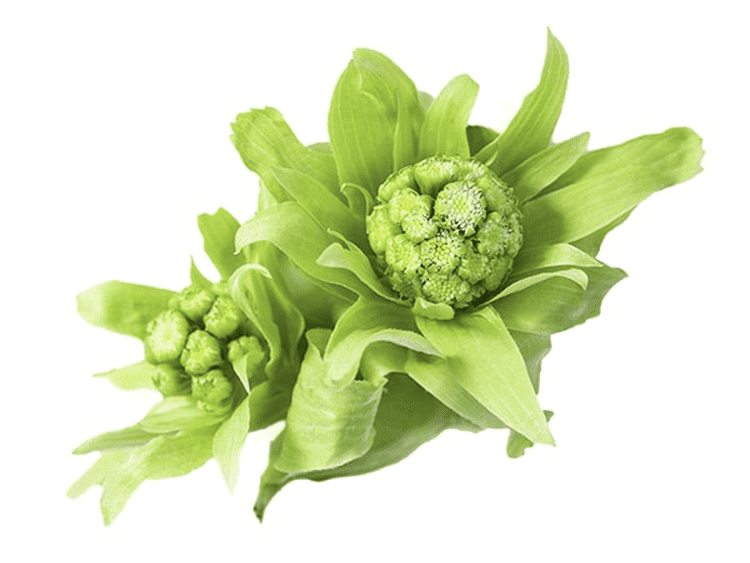BACKGROUND
Ingredient Type: Botanical, Extract
Also Known As: Petasites hybridus, Blatterdock, Bog rhubarb, Bogshorns, Butter bur, Butter-dock, Butterfly dock, Capdockin, Common butterbur

Butterbur is the common name of a genus of flowering plants in the sunflower family. It is a perennial shrub found throughout Europe, as well as temperate parts of Asia. It has also been naturalized in parts of the US (1). The common name, butterbur, is attributed to the fact that its large leaves were used historically to wrap butter during warm weather (2).
Butterbur roots and root extracts are used in health supplements today to support healthy blood flow in the head, to soothe respiratory irritation, and to calm the nervous system.
TRADITIONAL USES
Butterbur has been used medicinally for over 2000 years (1). In early Greek history, it was used to soothe the GI tract and for asthma attacks (3). During the Middle Ages, the use was extended to treat plague and fever (4). Later in the 17ths century, butterbur was used to treat a cough, asthma and skin wounds (5).
WHAT DOES SCIENCE TELL US?
Butterbur Root Extract Might Help With Headaches:
A specific butterbur rhizome extract that was free of hepatotoxic pyrrolizidine alkaloids (PAs) reduced the frequency, intensity, and duration of migraine headaches when used over a period of 16 weeks in adults (6,7,8). This extract seems to reduce the frequency of migraines by about 48% (8).
A clinical study in children found that taking a specific butterbur rhizome extract was superior to placebo and equivalent to music therapy in reducing migraine headaches (9). Another study also found that butterbur extract may decrease the frequency of migraine headaches in children aged 6-17 years (10).
SAFETY
Butterbur is shown to be safe when free of hepatotoxic pyrrolizidine alkaloid constituents. PA-free butterbur extract has been used in multiple trials for up to 16 weeks without significant side effects (5-10).
Pyrrolizidine alkaloids from unprocessed butterbur can cause liver damage and are carcinogenic. Those considering supplementation with butterbur should ensure that their butterbur product is PA-free.
REFERENCES
- Aydin AA, Zerbes V, Parlar H, and Letzel T. The medical plant butterbur (Petasites): analytical and physiological review. J Pharm Biomed Anal. 2013;75:220-229.
- Debrunner B and Meier B. Petasites hybridus: a tool for interdisciplinary research in phytotherapy. Pharm Acta Helv. 1998;72(6):359-362.
- Brune K, Bickel D, and Peskar BA. Gastro-protective effects by extracts of Petasites hybridus: the role of inhibition of peptido-leukotriene synthesis. Planta Med. 1993;59(6):494-496.
- Anon. Petasites hybridus. Altern Med Rev. 2001;6:207-209.
- Lee DK, Carstairs IJ, Haggart K, et al. Butterbur, a herbal remedy, attenuates adenosine monophosphate induced nasal responsiveness in seasonal allergic rhinitis. Clin Exp Allergy. 2003;33:882-886.
- Grossmann WM, Schmidramsl H. An extract of Petasites hybridus is effective in the prophylaxis of migraine. Int J Clin Pharmacol Ther. 2000;38:430-435.
- Diener HC, Rahlfs VW, Danesch U. The first placebo-controlled trial of a special butterbur root extract for the prevention of migraine: reanalysis of efficacy criteria. Eur Neurol. 2004;51:89-97.
- Lipton RB, Gobel H, Einhaupl KM, et al. Petasites hybridus root (butterbur) is an effective preventive treatment for migraine. Neurology 2004;63:2240-2244.
- Oelkers-Ax R, Leins A, Parzer P, et al. Butterbur root extract and music therapy in the prevention of childhood migraine: an explorative study. Eur J Pain. 2008;12:301-313.
- Pothmann R and Danesch U. Migraine prevention in children and adolescents: results of an open study with a special butterbur root extract. Headache. 2005;45:196-203.
See the National Center for Complementary and Integrative Health entry for butterbur or the Michigan Medicine Health Library entry for butterbur for more information.









